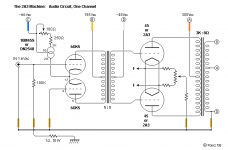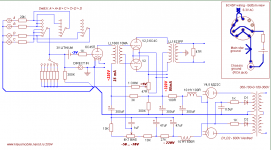Hi,
I am thinking of building a pair of monoblock valve amplifiers using modern components as the price of vintage valve amplifiers (Leak, QUAD etc.) is beyond my reach. In the past I have had Leak Stereo 20s, Leak TL12+, Leak TL50+ and QUAD II amplifiers and thought they sounded lovely with the right preamps and speakers. All these amplifiers I rebuilt to the original specification.
What I'm interested in finding out is what members here think of the quality of the output transformers on QUAD and Leak gear compared with modern components made by Danbury, for example. I chose them as their products look well specified and reasonably priced. Obviously, I wouldn't have to worry about 60 year old insulation in a modern transformer but would the Leak transformers be superior in terms of core material and interleaving to something from Danbury.
I suppose what I'm asking is would a well built amplifier correctly using Danbury transformers sound as good as an equivalent vintage amplifier in good condition ?
Yours,
Jolyon
I am thinking of building a pair of monoblock valve amplifiers using modern components as the price of vintage valve amplifiers (Leak, QUAD etc.) is beyond my reach. In the past I have had Leak Stereo 20s, Leak TL12+, Leak TL50+ and QUAD II amplifiers and thought they sounded lovely with the right preamps and speakers. All these amplifiers I rebuilt to the original specification.
What I'm interested in finding out is what members here think of the quality of the output transformers on QUAD and Leak gear compared with modern components made by Danbury, for example. I chose them as their products look well specified and reasonably priced. Obviously, I wouldn't have to worry about 60 year old insulation in a modern transformer but would the Leak transformers be superior in terms of core material and interleaving to something from Danbury.
I suppose what I'm asking is would a well built amplifier correctly using Danbury transformers sound as good as an equivalent vintage amplifier in good condition ?
Yours,
Jolyon
These vintage transformers were built to a strict budget which was not that high in the case of the LEAK's. I have heard it said that they are the weak link in the design.
I had a LEAK Stereo 20 and though I loved it, its presentation was very coloured.
If you can afford reasonable quality modern transformers (Sowters or Lundahl) then they should sound much less coloured than their vintage counterparts.
Remember that back then 12Khz was considered fullrange - which is severely limited by todays standards.
Shoog
I had a LEAK Stereo 20 and though I loved it, its presentation was very coloured.
If you can afford reasonable quality modern transformers (Sowters or Lundahl) then they should sound much less coloured than their vintage counterparts.
Remember that back then 12Khz was considered fullrange - which is severely limited by todays standards.
Shoog
Disagree.
Back in the 50s there was a defacto "standard" of 20cy - 20kc "flat" response from amplifiers.
The quality of output iron ranged from equal or better than today (Partridge, McIntosh) to worse.
There is no way to say one thing or another. Take each case separately.
_-_-bear
Back in the 50s there was a defacto "standard" of 20cy - 20kc "flat" response from amplifiers.
The quality of output iron ranged from equal or better than today (Partridge, McIntosh) to worse.
There is no way to say one thing or another. Take each case separately.
_-_-bear
If you do a search for Danbury on this forum you will find some rather mixed opinions. A lot of that was because they used to supply Maplin with basic transformers made to a price. The one you're looking at seems to be top of their line.
I have one of their 50W OPTs and a power tran in a guitar amp with 6L6GC PP. Works fine, easily makes the 50W. No nasty noises from the power tran either.
I think I took some basic measurements of that OPT, I'll see if I can find them in my notes tomorrow.
I have one of their 50W OPTs and a power tran in a guitar amp with 6L6GC PP. Works fine, easily makes the 50W. No nasty noises from the power tran either.
I think I took some basic measurements of that OPT, I'll see if I can find them in my notes tomorrow.
Thank you. I'd appreciate that. I have had a look at equivalent Sowter output transformers and they are over twice the price but they appear to be made using a split bobbin as per the Williamson design.
It's interesting what was said above about Leak transformers. I thought my TL12+ and Stereo 20s sounded lovely, the TL50+ less so so if the Danbury items are of a similar quality to classic Leak transformers then I will not be disappointed. I loved the QUAD IIs I had as well but it's interesting to note that their output transformers (15Watts +) have a far smaller core size than that specified by Williamson.
Now that leak TL12+ are on ebay for £1000 a pair I have given up hope of being able to find a good vintage pair of HiFi valve amps at a reasonable price hence my interest in constructing a pair and my questions about the quality of good vintage amplifier transformers compared with modern items such as made by Danbury.
Yrs,
Jolly
It's interesting what was said above about Leak transformers. I thought my TL12+ and Stereo 20s sounded lovely, the TL50+ less so so if the Danbury items are of a similar quality to classic Leak transformers then I will not be disappointed. I loved the QUAD IIs I had as well but it's interesting to note that their output transformers (15Watts +) have a far smaller core size than that specified by Williamson.
Now that leak TL12+ are on ebay for £1000 a pair I have given up hope of being able to find a good vintage pair of HiFi valve amps at a reasonable price hence my interest in constructing a pair and my questions about the quality of good vintage amplifier transformers compared with modern items such as made by Danbury.
Yrs,
Jolly
I can tell you about Danbury. I've used several of their DM53 PP OPTs, the ones sold extensively by Maplin. They sound very good. A fraction light in the bass, but excellent in the mid and treble. I enclose frequency response tests, and as you can see they are better than some vintage ones. I wouldn't hesitate to use them, and I've built some great soundiing amps with them. They're a real bargain.
But in a larger context, if your intention is to rebuild vintage amps to their original specifications - and that's fine in itself in a historical context - then you're taking a big dip in the quality of amp you could achieve with later and better sounding circuits. So the OPT may be one of the lesser factors in the overall sound. You'd get better results in sheer quality of listening with a Danbury transformer and a better amp - like a 2a3 PP type amp, for which you could use the excellent Russian 6C4C tubes. Put the money into a good interstage transformer instead and use a diff pair with something like a single high-mu input tube with the usual suspects - D3A, 6GK5, 6C45 etc
But in a larger context, if your intention is to rebuild vintage amps to their original specifications - and that's fine in itself in a historical context - then you're taking a big dip in the quality of amp you could achieve with later and better sounding circuits. So the OPT may be one of the lesser factors in the overall sound. You'd get better results in sheer quality of listening with a Danbury transformer and a better amp - like a 2a3 PP type amp, for which you could use the excellent Russian 6C4C tubes. Put the money into a good interstage transformer instead and use a diff pair with something like a single high-mu input tube with the usual suspects - D3A, 6GK5, 6C45 etc
Attachments
Those graphs are really interesting. Thank you very much. How much feedback was applied when those results were plotted ? I am now happy to use Danbury output transformers. I take your point about limitations to do with dated circuit topology. I need about about 25W per channel with my current insensitive speakers so was thinking of building a pair of amplifiers based on the Lowther LL26 circuit. I don't want to build vintage amps per se it's just that the ones I've had I have liked so they are my yardstick. I know relatively little about modern valve circuits so wouldn't know where to start.
Jolly
Jolly
Here's a simple circuit and a more complex one. You could simplify this further by using cathode bias in the outputs and by using a BC549 type constant current sink for the input stage as in Morgan Jones "Valve Amplifiers" which you should get and read. That runs off -15v which is easily done. There's also Allen Wright's cascode input stage. PP1C power amp
http://www.vacuumstate.com/index.dna?rubrik=8&lang=2&a=%20%5D%193x%DE%BF%E0&b=735126.4604230804
http://www.vacuumstate.com/index.dna?rubrik=8&lang=2&a=%20%5D%193x%DE%BF%E0&b=735126.4604230804
Attachments
Last edited:
I can tell you about Danbury. I've used several of their DM53 PP OPTs, the ones sold extensively by Maplin. They sound very good. A fraction light in the bass, but excellent in the mid and treble. I enclose frequency response tests, and as you can see they are better than some vintage ones. I wouldn't hesitate to use them, and I've built some great sounding amps with them. They're a real bargain.
Agreed - my amp based on the Maplin Millennium design using the Danbury transformers is still in daily use after almost 20 years. Very pleased with those output transformers.
- Status
- This old topic is closed. If you want to reopen this topic, contact a moderator using the "Report Post" button.
- Home
- Amplifiers
- Tubes / Valves
- The sound of modern transformers compared with vintage gear

